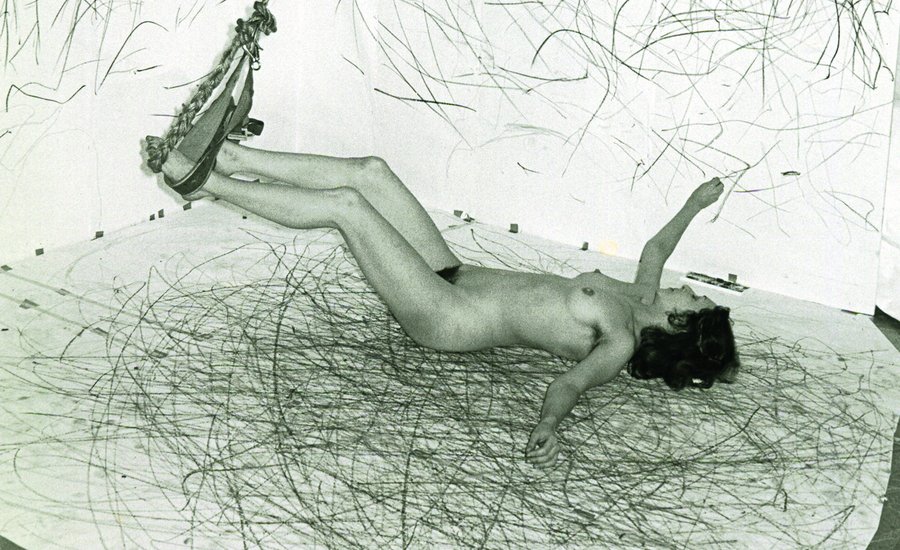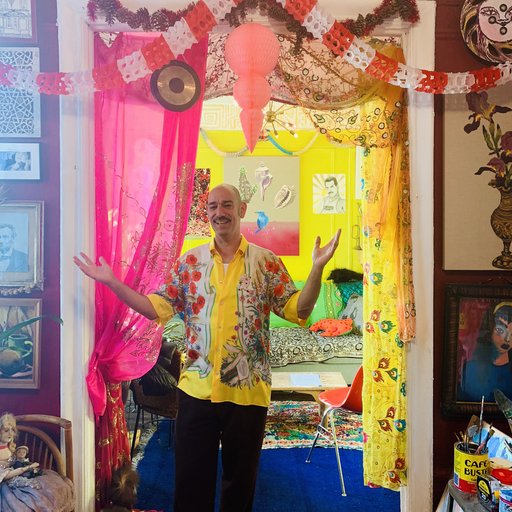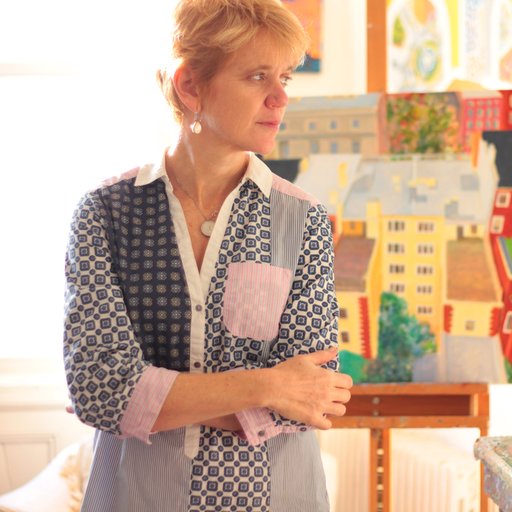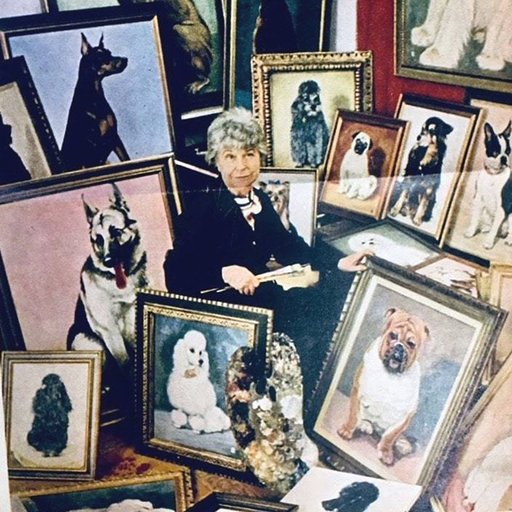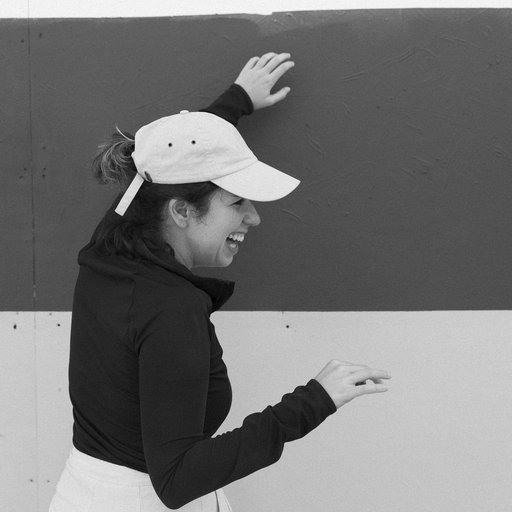On March 6, 2019, the world lost the icon, experimental artist, and feminist pioneer Carolee Schneemann, who died in New Paltz, New York at the age of 79. Schneemann’s iconoclastic perspective up-ended art world patriarchy by centering her own body not just as a source of content, but a site of artistic production. A canvas unto herself, Schneemann created the affectual road-map for generations of performance artists to come, catapulting intellectually generous and visually challenging conversations to the forefront of critical discourse. Schneemann considered herself a painter first, and that compositional sensibility informed her approach to a radically interdisciplinary career.
In honor of her peerless legacy, here are five good things to know about Carolee Schneemann:
1) She got suspended from undergrad for painting nude self-portraits.
Schneemann was given a scholarship to Bard in the late ‘50s, and was the first woman in her family to attend college. While generally discouraged from pursuing arts education by parents and professors alike, Schneemann excelled in her studies, pushing the envelope in every facet of her burgeoning practice. Her portraits posed an issue to the status quo, however, and after debuting some expressionist paintings of her own bare body in class, Schneemann was told to kick rocks by Bard’s senior faculty. Her departure turned out to be an unexpected stroke of luck; her next academic turn at Columbia University introduced her to her future partner of 12 years, experimental filmmaker James Tenney, with whom she went on to the University of Illinois Urbana-Champaign to earn an MFA. She caused quite a stir there, too—her tender, nude paintings of Tenney were much maligned for their gender-reversing bravado.
2) She spoke her mind to the establishment.
Schneemann was well-respected by peers and friends throughout her career, but it took a frustratingly long time for the art world to give her the props she deserved. Her Golden Lion Award for Lifetime Achievement didn’t manifest until 2017; her Guggenheim Memorial Foundation Fellowship only came to fruition in 1993. Schneemann was unafraid to call out gender iniquity in the art world, and her lightning-hot correspondence speaks directly to her distaste for letting prejudice linger un-addressed. In a 1999 letter to MacArthur Foundation Director Daniel Socolow, she turned down his request to nominate a candidate for the “genius” grant by using her own story as a battle ground. “I do not have savings, retirement funds, medical plan, investments, bonds, etc,” begins her argument, excerpted by Maggie Nelson in the most recent issue of the New Yorker. “People find it unbelievable that in thirty years I have sold only two works to museums in the U.S.A.... Perhaps you will understand that being in dire straits while enduring a fantasy of success and achievement makes it impossible to fulfill your request.” Brazen, confessional, and searingly frank, Schneemann had no fear in using herself as the primary text for her refutations.
3) She wasn’t here for anybody's sex-negative garbage.
At the outset of her career, Schneemann experienced pushback for her body-forward, sensual imagery; like her contemporary Hannah Wilke, Schneemann’s physical beauty was considered artistically deleterious to her pieces by a variety of feminist critics. In one typically candid interview excerpted in Artsy, the artist remarked, “It was also used against the seriousness of the work, you know. If she’s so sexy and so attractive, the work has got to be kind of stupid, or it can’t be as smart as she wants to imagine it is.” Schneemann’s continued focus on her own aging, unedited form eventually disavowed viewers of this notion, but she still felt willfully misunderstood by the art elite. Schneemann was a lifelong proponent of Wilhelm Reich, a student of Sigmund Freud who believed that “genital gratification” was vital for the advancement of social health and wellness; she never shied away from her conviction that sex was creatively generative and artistically misrepresented. In discussing her notorious 1964 film Meat Joy, an orgiastic bacchanal of writhing dancers and uncooked animal parts, she told Hans Ulrich Obrist, "There was no depiction of female sexuality that I had ever seen that corresponded to my sense of my own lived sexuality. People were always showing me pornography and it had nothing to do with my sense of body." Artist Johannes Birringer characterized Schneemann’s oeuvre as fundamentally bored by the “political correctness” that often dictated emergent feminist discourse, and it was her investment not in hedonism, but in self-directed liberation, that constituted the backbone of her artistic philosophy.
4) She was a founding collaborator in the Judson Dance Theater.
After receiving her MFA, Schneemann and Tenney moved to New York, then a hub for experimental, cross-genre art practice. Soon after landing, they became integral to the programmatic goings-on of the Judson Dance Theater, a bedrock series of workshops held by cutting-edge choreographers, visual artists, composers, and filmmakers in Judson Memorial Church, a progressive Protestant congregation in Greenwich Village. The Judson group was not just responsible for redefining the limits of dance, but for introducing bodily kineticism to a larger segment of creative thinkers the world over. A recently closed MoMA retrospective on the Judson Dance Theater included work from Schneemann, George Brecht, Allan Kaprow, Claes Oldenburg, and Robert Rauschenberg, among others. Traces of her involvement with Judson are apparent throughout her decades-long career, but nowhere is the influence more apparent than projects like her 1976 performance Up to and Including Her Limits, a live video relay of the artist swinging naked on a harness, reaching as far as she can towards the blank walls and floor in order to scrawl on their surfaces with a crayon.
5) She didn’t claim allegiance any particular movement.
Schneemann hated pigeon-holing, and her ever-changing aesthetic reflected that spirit of resistance. Instead of laboring under the weight of a signature style, she preferred to switch it up, seamlessly sampling a range of materials, color stories, subject matters, and visual languages, often combining disparate forms into large-scale tableaus that brimmed and bled with complex, emotive narrative. “The most important work is what I’m going to do tomorrow,” she told The Cut in 2016, and that attitude proved her driving force until the end; celebratory self-excavation at all costs. In her Feminist Artist Statement, on file at the Brooklyn Museum, Schneemann announced,
“Our feminism has initiated intellectual determinations transforming ecology, ethnology, anthropology, archeology, physiology, political domination, militarism, medical history, aesthetic reductionism, neurological properties—a revivification of knowledge and imagination.
Our feminism has transformed cultural inheritance, so that the creative intentions of younger artists develop fluidly within our radical precedents.”
Hers certainly did.
RELATED ARTICLES:
Carolee Schneemann on Embodying the "Movement from Interior Thought to External Signification"











